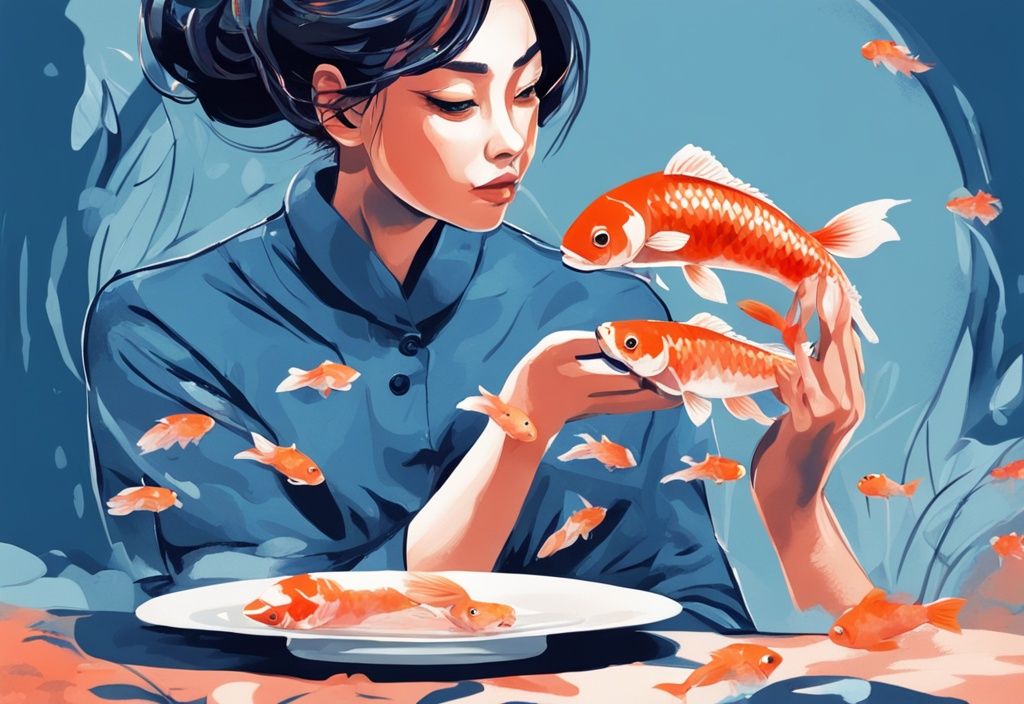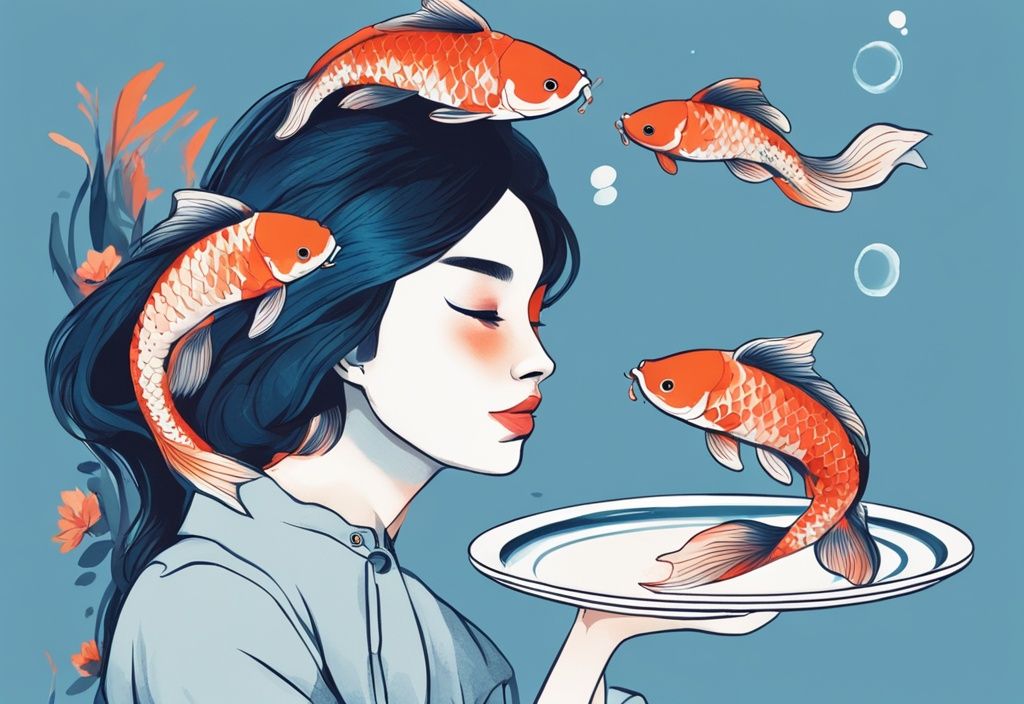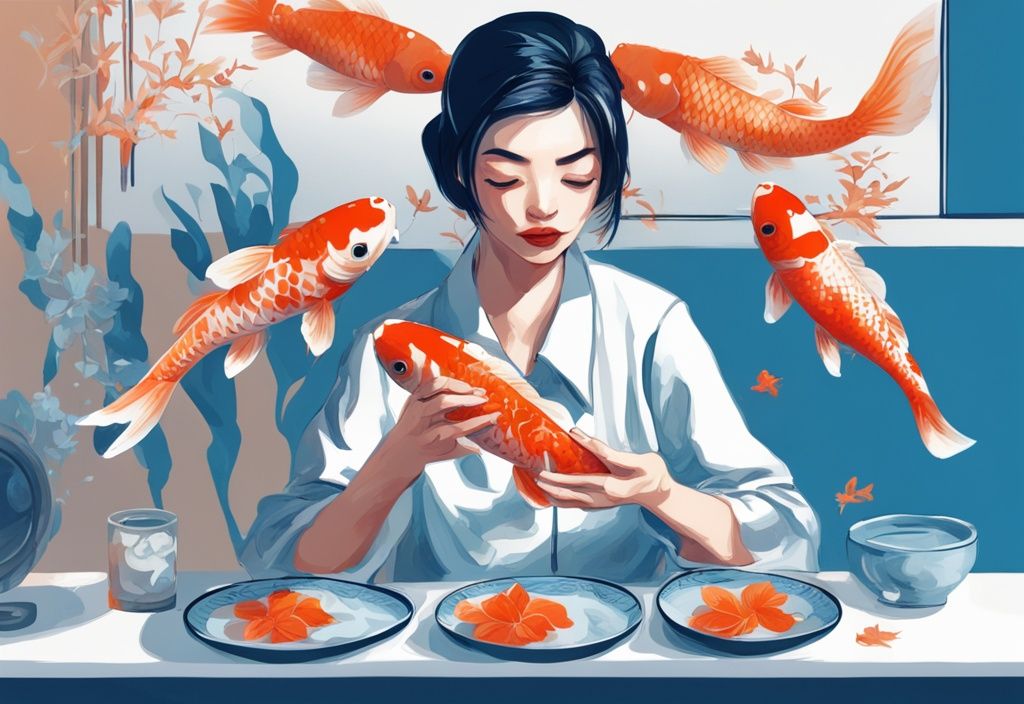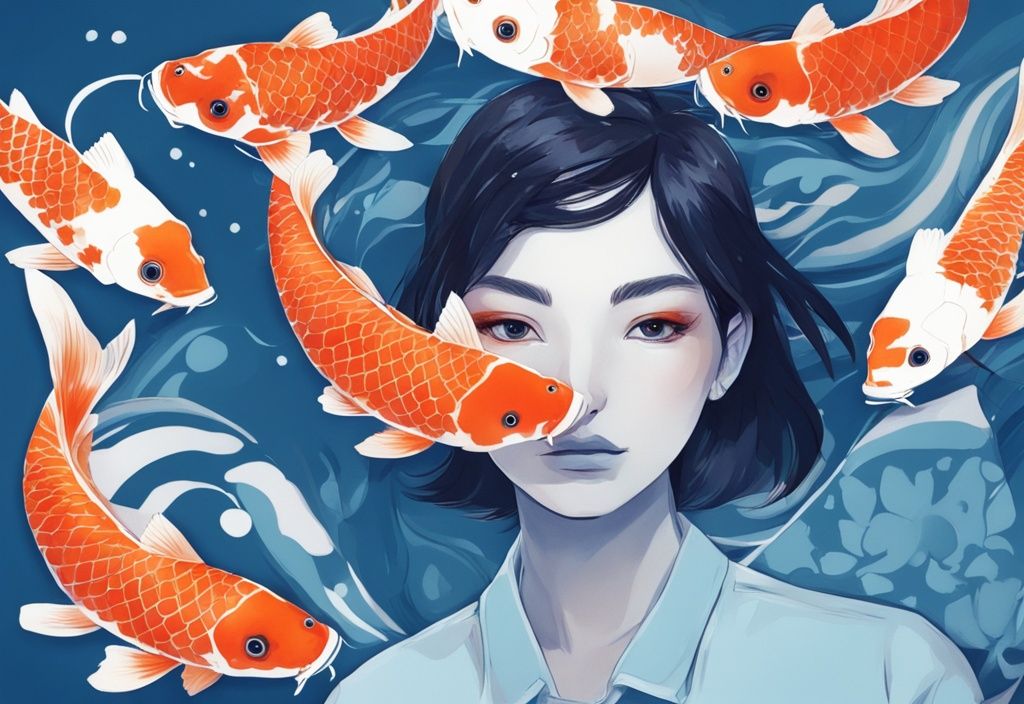Picture this: you’re by a tranquil pond, the sun warming your back, watching koi fish glide gracefully through the water. Now, here’s a curveball—can you eat koi fish? This question might seem as surprising as a sudden tug on your fishing line. Koi, with their dazzling colors, are usually admired, not eaten. But let’s dive into this culinary curiosity. Could these ornamental beauties also be a feast? We’ll explore taste, health factors, and cultural beliefs. So, grab your tackle box of curiosity and join me on this intriguing journey.

Can You Eat Koi Fish?
Koi fish, those dazzling members of the carp family, are technically edible. Yet, they’re not your typical dinner fare, mainly because they’re prized for their beauty rather than their flavor. Picture them gliding gracefully in garden ponds, their vibrant colors catching the sunlight. It’s no wonder they’re more cherished for their ornamental value than their culinary potential. Eating koi? Well, it’s not exactly a popular choice when there are other fish that are more suited to satisfy your taste buds.
Edibility of Koi Fish
Sure, koi fish are edible, just like other freshwater fish. But let’s be honest, they’re bred for their stunning colors and unique patterns, making them more like living art than a meal. In many cultures, koi hold symbolic meanings and are revered, which keeps them off the dinner plate. It’s like having a pet that doubles as a backyard masterpiece—why would you want to eat that?
Taste and Culinary Considerations
Now, if you’re curious about the taste, koi fish can have a bit of a muddy flavor, thanks to their bottom-feeding habits. To improve their taste, you might want to keep them in clean water for a couple of weeks before considering them for dinner. This helps cleanse the fish, reducing any off-putting flavors. But let’s face it, even with this prep, koi are more about their ornamental charm than their taste. Their role as decorative and symbolic creatures often outweighs any culinary considerations.
Health and Safety Concerns When Eating Koi Fish
Eating koi fish isn’t just about tossing a catch on the grill. There are some serious health and safety concerns to think about before you dig in. Let’s dive into these issues so you can make an informed decision.
Potential Health Risks
Koi fish might look pretty in your pond, but eating them can be a different story. These colorful creatures can carry parasites and bacteria that are no joke if they end up on your plate. And here’s the kicker: koi sold for decorative purposes might have been treated with chemicals or meds that are definitely not dinner-friendly. If you’re an angler, you might be interested in checking out the best 3 Daiwa spinning reels for a perfect catch. So, if you’re thinking about turning koi into a meal, it’s crucial to ensure they’re parasite-free and healthy. Proper cooking is your best friend here—it’s the only way to zap those pesky health hazards. Remember, caution is key when it comes to koi on your menu.
Importance of Sourcing and Preparation
Now, if you’re set on trying koi, where you get them from matters—a lot. Finding a supplier who raises koi for eating is your safest bet. These folks are more likely to keep their fish free from harmful substances. And don’t skimp on the cooking; thorough preparation is essential to kill any lurking parasites or bacteria. Keeping the fish in a clean environment before they hit your plate is another must. These steps are your ticket to enjoying koi without the worry.

Nutritional Value of Koi Fish
Koi fish are often admired for their vibrant colors and grace in garden ponds, but there’s more to these beauties than meets the eye. Let’s dive into their nutritional profile and see how they stack up against other fish.
Protein and Omega-3 Content
Ever wondered if those koi fish gliding in your pond could be more than just eye candy? Well, they pack a punch when it comes to protein and Omega-3 fatty acids. These nutrients are like the secret sauce for a healthy diet, boosting muscle growth and keeping your heart ticking like a well-oiled reel. But here’s the catch—koi fish are rarely on the menu. Their dazzling colors and ornamental allure often overshadow their culinary potential. It’s like having a Picasso in your backyard pond; you admire it, but you don’t fry it up for dinner.
Comparison with Other Fish
Now, if you’re thinking about swapping your salmon for koi, let’s pause for a moment. While koi fish have their nutritional perks, they’re not exactly the go-to choice for a fish fry. Why? Well, fish like salmon, tilapia, and trout are the popular kids in the culinary world. They’re tasty, affordable, and easy to find. If you’re keen on catching your own fish, knowing about the best fishing lines for spinning reels can enhance your angling experience. Koi, on the other hand, come with a hefty price tag due to their ornamental value and those mesmerizing color patterns. It’s like choosing between a reliable fishing rod and a collector’s item—you know which one you’ll actually use on your next fishing trip. So, while koi might be swimming in nutrients, most folks stick to more traditional and budget-friendly fish that deliver the same health benefits without breaking the bank.
Cultural Significance of Koi Fish in Relation to Eating
Symbolism in Japanese Culture
Koi fish are more than just vibrant swimmers in Japanese waters; they’re living symbols of love, friendship, and perseverance. Imagine a koi gliding through a serene pond, its colors reflecting the beauty and grace that have made it a beloved fixture in Japanese gardens. These fish aren’t just pretty to look at—they embody strength and determination, especially when they swim upstream. This cultural reverence elevates koi fish to a status far beyond that of a simple aquatic creature. They’re woven into the very fabric of Japanese heritage and tradition, making it hard to even think of them as a food source. Who would want to eat a symbol of positive virtues anyway?
Is Eating Koi Fish Considered Taboo?
In many cultures, the idea of eating koi fish is like trying to eat a piece of art—it just feels wrong. These fish are esteemed as ornamental beings, highly valued for their beauty and cultural significance. Eating them would clash with their role as symbols of prosperity and beauty. It’s like taking a masterpiece off the wall and using it as a dinner plate. Their ornamental value and cultural importance discourage their consumption, reinforcing the idea that koi are meant to be admired, not eaten.

FAQ
Are Koi Fish Safe to Eat?
Imagine this: you’re eyeing that vibrant koi fish, wondering if it’s fit for the dinner table. Well, rest easy, my friend. Koi fish can indeed be safe to eat if you get them from trustworthy sources and cook them thoroughly. Just picture them sizzling in the pan! But here’s the catch—make sure they’re free from pesky parasites and any harmful chemicals, especially those bred for their ornamental beauty.
How Should Koi Fish Be Prepared for Eating?
Now, let’s dive into the nitty-gritty of preparing koi fish. Before you even think about cooking, let them swim in clean water for a few weeks. This little trick helps improve their taste. Once that’s done, cook them thoroughly. You want to eliminate any health risks, ensuring a delicious and safe meal. Who knew koi could be more than just a pretty face?
Why Are Koi Fish So Expensive?
Ever wonder why koi fish cost an arm and a leg? It’s all about their size, those mesmerizing markings, and vibrant patterns. They’re like living art, each one unique and often seen as a prized possession in ornamental fish circles. It’s this blend of beauty and rarity that drives their price up. Additionally, enthusiasts might also be interested in understanding related topics like what are fishing swivels and their importance in the fishing world. So, next time you see a koi, remember, you’re looking at a swimming masterpiece!
Conclusion
Koi fish, while technically edible, are rarely on the menu for a few good reasons. First off, their ornamental charm far surpasses any culinary interest. These colorful beauties are more than just fish; they’re living art. In places like Japan, they symbolize love and friendship, adding layers of cultural significance that elevate them beyond a simple food source.
Now, let’s talk about health risks. As ornamental creatures, koi might have been exposed to chemicals or medications that aren’t safe for us to eat. Plus, they can carry parasites and bacteria, so if you’re ever tempted to try one, sourcing from a reputable supplier and cooking thoroughly is a must.
From a taste perspective, koi fish aren’t exactly a catch of the day. Their bottom-feeding habits can give them a muddy flavor, and they’re bred more for their looks than their taste. There are plenty of other fish out there with better flavor profiles that won’t break the bank.
Speaking of cost, koi fish are often expensive due to their unique patterns and vibrant colors. It’s like eating a piece of art—just not the most economical choice for a meal. So, while you can eat koi fish, their ornamental value, health considerations, taste, and cultural significance make them better suited for ponds than plates.


